跨文化沟通(cross-culture-communication)
- 格式:ppt
- 大小:3.61 MB
- 文档页数:21
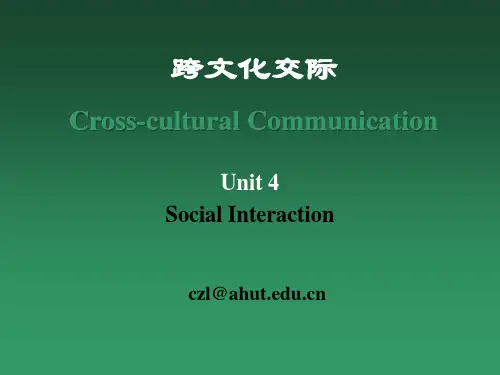
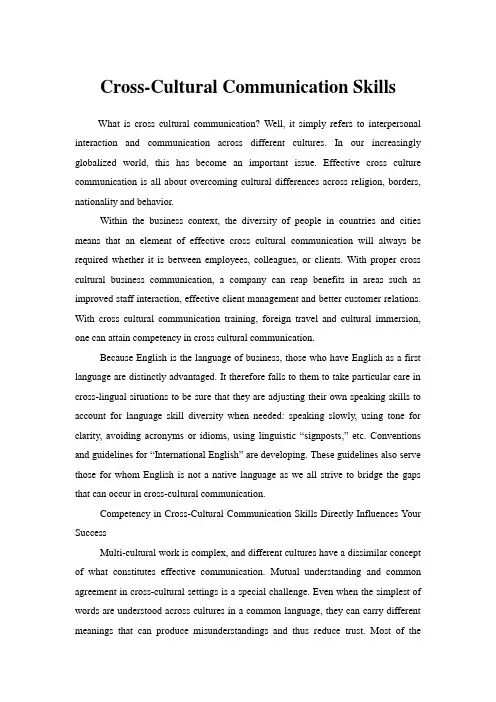
Cross-Cultural Communication SkillsWhat is cross cultural communication? Well, it simply refers to interpersonal interaction and communication across different cultures. In our increasingly globalized world, this has become an important issue. Effective cross culture communication is all about overcoming cultural differences across religion, borders, nationality and behavior.Within the business context, the diversity of people in countries and cities means that an element of effective cross cultural communication will always be required whether it is between employees, colleagues, or clients. With proper cross cultural business communication, a company can reap benefits in areas such as improved staff interaction, effective client management and better customer relations. With cross cultural communication training, foreign travel and cultural immersion, one can attain competency in cross cultural communication.Because English is the language of business, those who have English as a first language are distinctly advantaged. It therefore falls to them to take particular care in cross-lingual situations to be sure that they are adjusting their own speaking skills to account for language skill diversity when needed: speaking slowly, using tone for cl arity, avoiding acronyms or idioms, using linguistic “signposts,” etc. Conventions and guidelines for “International English” are developing. These guidelines also serve those for whom English is not a native language as we all strive to bridge the gaps that can occur in cross-cultural communication.Competency in Cross-Cultural Communication Skills Directly Influences Your SuccessMulti-cultural work is complex, and different cultures have a dissimilar concept of what constitutes effective communication. Mutual understanding and common agreement in cross-cultural settings is a special challenge. Even when the simplest of words are understood across cultures in a common language, they can carry different meanings that can produce misunderstandings and thus reduce trust. Most of thechallenges caused by cross-cultural clashes are the result of the failure by some or all parties involved to recognize and account for differences in culturally-based communication styles.Below are some guidelines to help improve your cross cultural communication skills.Cross cultural communications require the following:Listening skills. This is a key skill that many business personnel do not exercise enough. To avoid any cross cultural communication problems, attentive listening is critical to be able to understand meanings and empathize with the speaker.Speaking skills. Speaking well is not about accent, use of grammar and vocabulary or having the "gift of the gab" Rather, cross cultural communication is enhanced through positive speech such as encouragement, recognition or expressing opinions sensitively.Observation. To over any cross cultural communication barriers, one need to be more observant of people's dress, body language, interaction and behavior, as these details contain large amounts of cross cultural information.Patience. While there are times when cross cultural differences can be annoying and frustrating, patience is definitely a virtue in such cases. Through patience, respect can be won and cross cultural understanding will be enhanced.Flexibility. You must be open-minded and adaptable if you wish to achieve successful cross cultural communication. Understanding and addresses cross cultural differences can lead to a breakdown of cultural barriers which in turn lead to better communication and stronger trust between both parties.Following the 5 above-mentioned cross cultural communication needs will help to improve communication and pave the path towards stronger cross cultural relationships.。

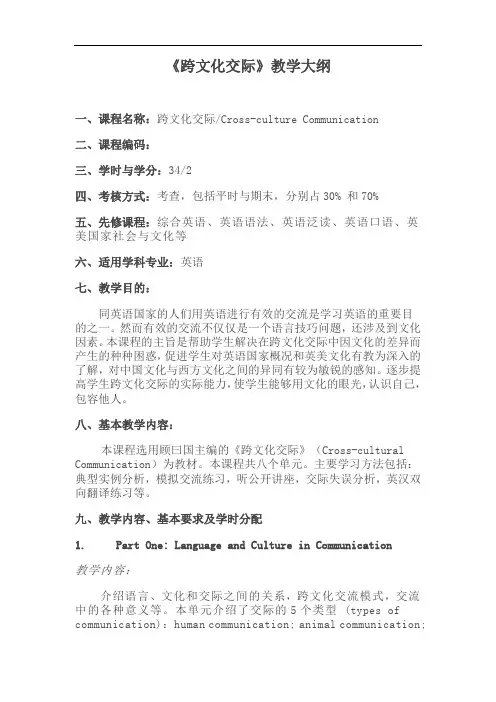
《跨文化交际》教学大纲一、课程名称:跨文化交际/Cross-culture Communication二、课程编码:三、学时与学分:34/2四、考核方式:考查,包括平时与期末,分别占30% 和70%五、先修课程:综合英语、英语语法、英语泛读、英语口语、英美国家社会与文化等六、适用学科专业:英语七、教学目的:同英语国家的人们用英语进行有效的交流是学习英语的重要目的之一。
然而有效的交流不仅仅是一个语言技巧问题,还涉及到文化因素。
本课程的主旨是帮助学生解决在跨文化交际中因文化的差异而产生的种种困惑,促进学生对英语国家概况和英美文化有教为深入的了解,对中国文化与西方文化之间的异同有较为敏锐的感知。
逐步提高学生跨文化交际的实际能力,使学生能够用文化的眼光,认识自己,包容他人。
八、基本教学内容:本课程选用顾曰国主编的《跨文化交际》(Cross-cultural Communication)为教材。
本课程共八个单元。
主要学习方法包括:典型实例分析,模拟交流练习,听公开讲座,交际失误分析,英汉双向翻译练习等。
九、教学内容、基本要求及学时分配1. Part One: Language and Culture in Communication教学内容:介绍语言、文化和交际之间的关系,跨文化交流模式,交流中的各种意义等。
本单元介绍了交际的5个类型 (types of communication):human communication; animal communication;human-animal communication; human-machine communication; machine-to-machine communication;交际的基本模式:同文化交际(mono-cultural language communication);跨文化交际(cross-cultural language communication);介绍各种交际方式中的“意思”的传达。

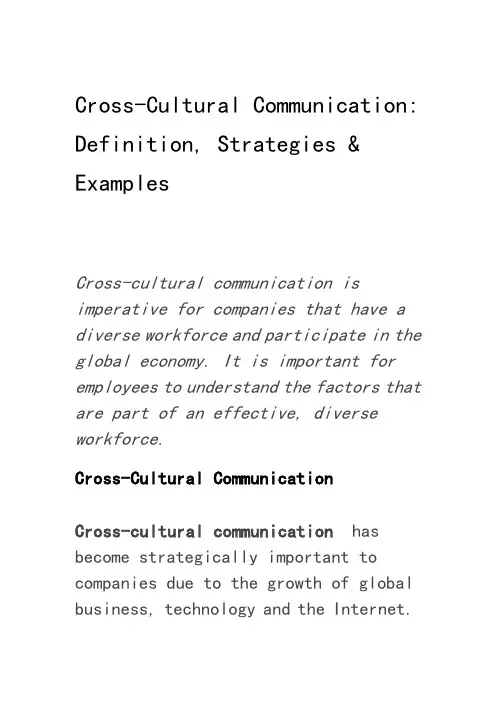
Cross-Cultural Communication: Definition, Strategies & ExamplesCross-cultural communication is imperative for companies that have a diverse workforce and participate in the global economy. It is important for employees to understand the factors that are part of an effective, diverse workforce.Cross-Cultural CommunicationCross-cultural communication has become strategically important to companies due to the growth of global business, technology and the Internet.Understanding cross-cultural communication is important for any company that has a diverse workforce or plans on conducting global business. This type of communication involves an understanding of how people from different cultures speak, communicate and perceive the world around them.Cross-cultural communication in an organization deals with understanding different business customs, beliefs and communication strategies. Language differences, high-context vs.low-context cultures, nonverbal differences and power distance are major factors that can affectcross-cultural communication.Let's take a look at how cross-cultural differences can cause potential issues within an organization. Jack is amanager at a New Mexico-based retail conglomerate. He has flown to Japan to discuss a potential partnership with a local Japanese company. His business contact, Yamato, is his counterpart within the Japanese company. Jack has never been to Japan before, and he's not familiar with their cultural norms. Let's look at some of the ways that a lack of cultural understanding can create a barrier for business success by examining how Jack handles his meeting with Yamato.High- Vs. Low-Context CultureThe concept of high- and low-context culture relates to how an employee's thoughts, opinions, feelings and upbringing affect how they act within a given culture. North America and Western Europe are generally consideredto have low-context cultures. This means that businesses in these places have direct, individualistic employees who tend to base decisions on facts. This type of businessperson wants specifics noted in contracts and may have issues with trust.High-context cultures are the opposite in that trust is the most important part of business dealings. There are areas in the Middle East, Asia and Africa that can be considered high context. Organizations that havehigh-context cultures are collectivist and focus on interpersonal relationships. Individuals fromhigh-context cultures might be interested in getting to know the person they are conducting business with in order to get a gut feeling on decision making. They may also be more concernedabout business teams and group success rather than individual achievement.Jack and Yamato ran into some difficulties during their business negotiations. Jack spoke quickly and profusely because he wanted to seal the deal as soon as possible. However, Yamato wanted to get to know Jack, and he felt that Jack spoke too much. Yamato also felt that Jack was only concerned with completing the deal for his own self-interest and was not concerned with the overall good of the company. Jack's nonverbal cues did not help the negotiations either.Nonverbal DifferencesGestures and eye contact are two areas of nonverbal communication that areutilized differently across cultures. Companies must train employees in the correct way to handle nonverbal communication as to not offend other cultures. For example, American workers tend to wave their hand and use a finger to point when giving nonverbal direction. Extreme gesturing is considered rude in some cultures. While pointing may be considered appropriate in some contexts in the United States, Yamato would never use a finger to point towards another person because that gesture is considered rude in Japan. Instead, he might gesture with an open hand, with his palm facing up, toward the person.Eye contact is another form of nonverbal communication. In the ., eye contact is a good thing and is seen as a reflection of honesty and straightforwardness.However, in some Asian and Middle Eastern cultures, prolonged eye contact can be seen as rude or aggressive in many situations. Women may need to avoid it altogether because lingering eye contact can be viewed as a sign of sexual interest. During their meeting, Jack felt that Yamato was not listening to his talking points because Yamato was not looking Jack in the eyes. However, Yamato did not want Jack to think he was rude, so he avoided looking directly into Jack's eyes during his speech.Language DifferencesThe biggest issue dealing withcross-cultural communication is the difficulty created by language barriers. For example, Jack does not speak Japanese, so he is concerned with his ability to communicate effectively withYamato. There are some strategies that Jack can use to help establish a rapport with Yamato. Jack can explain himself without words by using emotions, facial expressions and other nonverbal cues. He can also use drawings and ask for an interpreter.Additionally, companies that have to deal with cross-cultural communication can hire employees with proficiency in other languages. Fortunately for Jack and Yamato, they both had excellent translators who communicated their words. The next cross-cultural issue regards how individuals deal with power distance.Power DistancePower distance relates to how power is distributed within an organization. Typically, American companies utilize a low power distance and have more informal hierarchies that allow for interaction between executives and their subordinates. Managers ask for feedback from employees and will even socialize with subordinates. Companies with high power distance are typically very hierarchical in nature and have severe differences in authority. Some Japanese companies may utilize this power structure.。

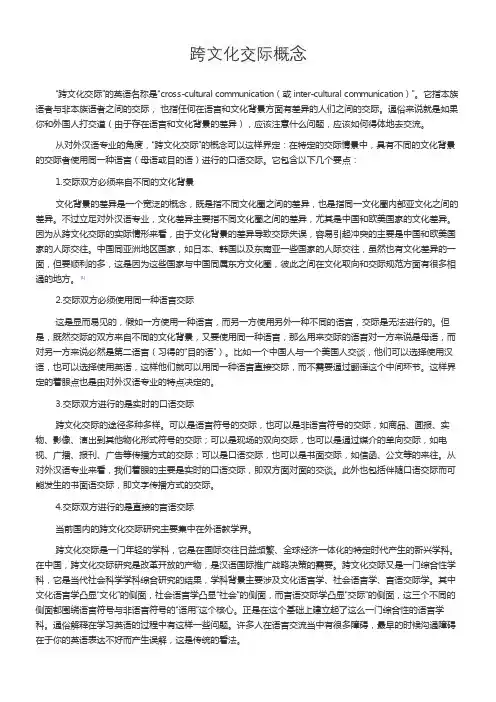
跨文化交际概念“跨文化交际”的英语名称是“cross-cultural communication(或inter-cultural communication)”。
它指本族语者与非本族语者之间的交际,也指任何在语言和文化背景方面有差异的人们之间的交际。
通俗来说就是如果你和外国人打交道(由于存在语言和文化背景的差异),应该注意什么问题,应该如何得体地去交流。
从对外汉语专业的角度,“跨文化交际”的概念可以这样界定:在特定的交际情景中,具有不同的文化背景的交际者使用同一种语言(母语或目的语)进行的口语交际。
它包含以下几个要点:1.交际双方必须来自不同的文化背景文化背景的差异是一个宽泛的概念,既是指不同文化圈之间的差异,也是指同一文化圈内部亚文化之间的差异。
不过立足对外汉语专业,文化差异主要指不同文化圈之间的差异,尤其是中国和欧美国家的文化差异。
因为从跨文化交际的实际情形来看,由于文化背景的差异导致交际失误,容易引起冲突的主要是中国和欧美国家的人际交往。
中国同亚洲地区国家,如日本、韩国以及东南亚一些国家的人际交往,虽然也有文化差异的一面,但要顺利的多,这是因为这些国家与中国同属东方文化圈,彼此之间在文化取向和交际规范方面有很多相通的地方。
[1]2.交际双方必须使用同一种语言交际这是显而易见的,假如一方使用一种语言,而另一方使用另外一种不同的语言,交际是无法进行的。
但是,既然交际的双方来自不同的文化背景,又要使用同一种语言,那么用来交际的语言对一方来说是母语,而对另一方来说必然是第二语言(习得的“目的语”)。
比如一个中国人与一个美国人交谈,他们可以选择使用汉语,也可以选择使用英语,这样他们就可以用同一种语言直接交际,而不需要通过翻译这个中间环节。
这样界定的着眼点也是由对外汉语专业的特点决定的。
3.交际双方进行的是实时的口语交际跨文化交际的途径多种多样。
可以是语言符号的交际,也可以是非语言符号的交际,如商品、画报、实物、影像、演出到其他物化形式符号的交际;可以是现场的双向交际,也可以是通过媒介的单向交际,如电视、广播、报刊、广告等传播方式的交际;可以是口语交际,也可以是书面交际,如信函、公文等的来往。

跨文化交际学(Intercultural Communication又称Cross-cultural Communication)是一门新兴的边缘学科。
跨文化交际学(Intercultural Communication又称Cross-cultural Communication)是一门新兴的边缘学科。
跨文化交际既指不同民族不同语言之间的交际,也指不同民族同一语言之间的交际。
也有人认为跨文化交际是泛指一切在语言与文化背景有差异的人们之间的交际。
如果从对比语言学角度出发,则认为跨文化交际学主要还是研究不同民族在跨文化语言交际和非语言交际方面的问题,分析社会习俗、价值观念、文化传统对交际的影响及可能造成的障碍,研究交际原则与方式及通过外语教学传授异文化知识的途径与方法⋯。
四、结论跨文化交际的过程既涉及文化的规约也涉及语言的规约。
不同的文化要求不同的行为,这是一种文化规约;不同文化背景的人们都各自有一套说话规约或习惯,这是语言的规约。
在跨文化的交际中,人们总是习惯于用自己的说话方式来解释对方的话语。
这就可能对对方的话语做出不正确的推论”。
因此,在跨文化交际时,交谈双方一旦发现谈话方式上的差异,则应主动采取非语言交际这一措施来防止发生交际故障和冲突。
而在跨文化言语交际中由于我们缺乏敏感,常常容易忽视非语言交际这一重要方面。
所以,我们在进行交际时,应开始逐步的认识到非语言交际的重要性,也要越来越重视对于非语言交际的研究。
总之,我们应在不断的实践中对非语言交际的特点和功能加以认识,以帮助我们达到更好的交流效果,在跨文化交往中避免交际故障。
通过对各文化肢体语言差异性的研究,我们能更好地理解交际对象,或者他们话语中可能有的言外之意。
所以这种研究可以降低误解的机率,能使我们更有效顺畅地开展跨文化交际。
并且,对各文化环境语言差异性的研究可以帮我们建立起目标文化的整套概念,了解为什么他们有这样、那样的举动,什么能说得过去,什么无法容忍。

目前,跨文化交际学已发展成为一门被国际学者们充分重视的集人类学、语言学、心理学、传播学、社会学等为一体的综合性学科。
4.文化差异文化差异是由各国的历史传统以及不同的社会发展进程所产生的,表现在社会文化的各个方面。
从霍氏的各文化维度指标值中,可得出东西方的文化差异是十分明显的,就是在同为东方文化圈的中国大陆、日本、中国香港、新加坡等也是较明显的。
就如中日两国文化都是一种集体主义导向,但两种集体主义却有较大的不同。
此外,除了民族、地域文化差异之外,不可否认,还有投资合作伙伴“公司文化”的风格差异。
可以说,公司内文化差距越大,产生文化冲突与困惑的可能性与强度就会越来越大。
霍夫斯坦特对文化下了这样一个定义:所谓“文化”,是在同一个环境中的人民所具有的“共同的心理程序”。
因此,文化不是一种个体特征,而是具有相同社会经验、受过相同教育的许多人所共有的心理程序。
不同的群体,不同的国家或地区的人们,这种共有的心理程序之所以会有差异,是因为他们向来受着不同的教育、有着不同的社会和工作,从而也就有不同的思维方式。
(权力距离、不确定性避免、个人主义与集体主义、男性度与女性度、长期取向与短期取向)5、文化词,什么是文化词呢?文化词就是指蕴含社会文化意义的词语,文化意义就是指社会赋予词语的引申义、联想义、比喻义、象征义等。
文化词与民族心理、风俗习惯和社会变革等密切相关,是词汇中最活跃的部分。
文化词和其他词汇一起组成了语言的底座,与语言紧密相随,在语言中也随处可见。
通过多年的对外汉语教学我发现,对留学生的文化词教学仅仅停留在词汇的表层意义上已经不能满足学生对汉语深层意蕴的渴求,文化词教学在对外汉语教学中是一个必须面对又很难把握的环节,甚至很多老师还没有认识到文化词教学其实是对外汉语教学的一部分。
6、体态语释义:又称“身体语言”。
是用身体动作来表达情感、交流信息、说明意向的沟通手段。
包括姿态、手势、面部表情和其他非语言手段,如点头、摇头、挥手、瞪眼等。

跨文化交际英语跨文化交际英语是:cross-cultural communication。
例句:1、在跨文化交际过程中,语言禁忌的问题往往会成为影响交际顺利进行的一个重要因素。
More attention must be paid to language taboos during our cross-cultu ral communication.2、在跨文化交际中,由于文化和价值观的普遍性,使得顺利地沟通成为可能,但因其差异性,交际受到了种种负面影响。
During the cross-cultural communication, the commonness will make the effective communication possible, while the differences could cause negative results.3、这将有助于培养学生的实际语言能力、文化意识和跨文化交际能力。
This aims to help foster students' practical language capacity, cultural a wareness and intercultural communication skills.4、如果能够理解其他文化、价值观,根据他们的价值观行事,你会在跨文化交际中避免很多麻烦。
If you can accept that people from other cultures, act according to their values, not yours, getting along with them will be much easier.5、在这种形势下,个人必须具备创造性和跨文化交际能力,死板地工作是无法生存的。
Where individuals are expected to innovate and communicate across cu ltures, and where a defined employee role may not exist.。
"Cross-cultural communication" 是指在不同文化背景下进行交流和理解的过程。
在许多情境下,人们可能会用以下表达来描述跨文化交际:
1. Intercultural Communication: 跨文化交际的常用术语。
2. Cultural Exchange: 文化交流,表示在不同文化间分享和交流信息。
3. Global Communication: 全球交流,指的是超越国界进行的跨文化沟通。
4. Diversity and Inclusion: 多元性与包容,强调在交际中考虑和尊重不同文化的多样性。
5. Interpersonal Understanding: 人际理解,强调在交流中理解和尊重他人的文化差异。
6. Cultural Sensitivity: 文化敏感性,指的是在交际中考虑并尊重他人的文化背景。
7. Adaptation and Adjustment: 适应与调整,表示在不同文化环境中调整自己的交际方式以融入当地文化。
8. Global Citizenship: 全球公民意识,鼓励个体在跨文化交际中具有开放、包容和全球意识。
9. Cultural Intelligence (CQ): 文化智商,强调个体在不同文化中有效交往的能力。
10. Bridging Cultural Divides: 架桥文化分歧,表示尝试弥合不同文化间的差异。
在任何跨文化交际中,理解文化差异的重要性以及尊重他人文化的价值观是关键。
这些表达可以帮助描述和促进在多元文化背景中的有效交际。
目前,跨文化交际学已发展成为一门被国际学者们充分重视的集人类学、语言学、心理学、传播学、社会学等为一体的综合性学科。
4.文化差异文化差异是由各国的历史传统以及不同的社会发展进程所产生的,表现在社会文化的各个方面。
从霍氏的各文化维度指标值中,可得出东西方的文化差异是十分明显的,就是在同为东方文化圈的中国大陆、日本、中国香港、新加坡等也是较明显的。
就如中日两国文化都是一种集体主义导向,但两种集体主义却有较大的不同。
此外,除了民族、地域文化差异之外,不可否认,还有投资合作伙伴“公司文化”的风格差异。
可以说,公司内文化差距越大,产生文化冲突与困惑的可能性与强度就会越来越大。
霍夫斯坦特对文化下了这样一个定义:所谓“文化”,是在同一个环境中的人民所具有的“共同的心理程序”。
因此,文化不是一种个体特征,而是具有相同社会经验、受过相同教育的许多人所共有的心理程序。
不同的群体,不同的国家或地区的人们,这种共有的心理程序之所以会有差异,是因为他们向来受着不同的教育、有着不同的社会和工作,从而也就有不同的思维方式。
(权力距离、不确定性避免、个人主义与集体主义、男性度与女性度、长期取向与短期取向)5、文化词,什么是文化词呢?文化词就是指蕴含社会文化意义的词语,文化意义就是指社会赋予词语的引申义、联想义、比喻义、象征义等。
文化词与民族心理、风俗习惯和社会变革等密切相关,是词汇中最活跃的部分。
文化词和其他词汇一起组成了语言的底座,与语言紧密相随,在语言中也随处可见。
通过多年的对外汉语教学我发现,对留学生的文化词教学仅仅停留在词汇的表层意义上已经不能满足学生对汉语深层意蕴的渴求,文化词教学在对外汉语教学中是一个必须面对又很难把握的环节,甚至很多老师还没有认识到文化词教学其实是对外汉语教学的一部分。
6、体态语释义:又称“身体语言”。
是用身体动作来表达情感、交流信息、说明意向的沟通手段。
包括姿态、手势、面部表情和其他非语言手段,如点头、摇头、挥手、瞪眼等。